T
tabeculate (tab-ih-KUY-layt) Cross-barred.
tabularis, -e (tab-ew-LAY-riss) Having a flat surface like a table or board; tablelike.
taedigerus, -a, -um (tee-DIJ-er-us) Torch-bearing.
taenialis, -e (tee-nee-AY-liss) Ribbonlike; banded.
Tang, T. (1894—1984) Chinese orchidologist who published with F.T. Wang.
taurinus, -a, -um (taw-RYE-nus) Having horns like a bull; bull-like.
taxon (pl. taxa) (TAKS-on) A general term applied to a taxonomic category of any rank, such as species, genus, family, order, etc.
taxonomy (tak-SON-oh-mee) The science of classification, dealing with the arrangement of plants (or animals) into groups according to natural relationships.
tardus, -a, -um (TAR-dus) Late.
Telipogon: Telipogon hausmannianus, from Colombia, Ecuador and Venezuela
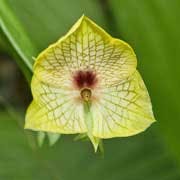
Telipogon (tel-i-POH-gon) A genus of 100 species of tropical American dwarf epiphytic orchids found in the high cloud forests from Costa Rica to Peru. It was established by Humboldt, Bonpland and Kunth in 1815, the name descriptive of the bearded column.
tendril (TEN-drill) A twisting threadlike process of extension by which a plant grasps an object and clings to it for support; morphologically it may be stem or leaf.
tenebrosus, -a, -um (ten-eh-BROH-sus) Dark; growing in shaded places.
tenuifolius, -a, -um (ten-yew-ee-FOH-lee-us) Slender-leaved.
tenuis, -e (TEN-yew-iss) Slender; delicate.
teratological (ter-a-toh-LOJ-ik-ul) Monstrous; relating to a monstrosity.
teres (TEH-reez) Long and cylindrical; terete.
terete (teh-REET) Cylindrical; circular in cross section.
teretifolia: Dendrobium teretifolia has leaves that are circular in cross section.
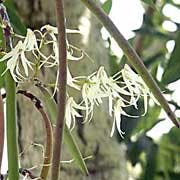
teretifolius, -a, -um (teh-ree-ti-FOH-lee-us) Having terete leaves.
terminal (ter-MIN-uhl) Apical; produced at the end.
terminology (ter-min-OL-a-gee) The system of terms dealing with a given science or subject.
ternatus, -a, -um (ter-NAY-tus) In clusters of three; ternate.
terrestrial (ter-RESS-tree-uhl) Growing in the ground and supported by soil.
terrestris, -e (ter-REST-tris) Of the ground; growing in the ground as opposed to growing in trees, on rocks, or in water.
tessellatus, -a, -um (tess-sel-LAY-tus) Arranged in a checkered or mosaic pattern; tessellated.
testa (pl. testae) (TESS-ta; TESS-tee) The outer seed coat, particularly when bony, hard or brittle.
testacea: Vanda testacea has brick-red flowers.
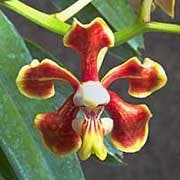
testaceus, -a, -um (tes-TAY-se-us) Of a brick-red or brownish-red color; testaceous.
tetrad (TET-rad) A structure formed of four cells, as in the pollen mother-cells; a group of four.
tetragonus, -a, -um (tet-trah-GO-nus) Having four angles.
tetramerous Any group with four members.
Tetramicra (te-tra-MYE-kra) A genus of 11 species of epiphytic orchids from the Caribbean related to Laelia and Cattleya. It was established in 1831 by Lindley, the name referring to the four small compartments of the anthers.
tetraploid (TET-tra-ployd) Having four sets of chromosomes (4N).
Teuscher, Heinrich ("Henry") (1891—1984) German botanist at the Montreal Botanical Garden (curator; 1936—1972) who authored the long-running series "Collector's Item" in American Orchid Society Bulletin (1953—1978).
Teuscheria (TOY-shur-ee-a) The six epiphytic species in this genus range from Costa Rica south to Peru. Garay established the genus in 1958, naming it in honor of Canadian botanist Henry Teuscher.
thalloid (THAL-loyd) Looking like a thallus.
thallus (THAL-uhs) Said of a plant part that does not have true roots, stem or leaves
Thecopus: Thecopus maingayi is found in Thailand, Viet Nam, Borneo and Malaysia.
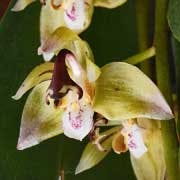
Thecopus (THEE-ko-puss) A small genus of two epiphytic species native from Thailand southeast to Borneo. Seidenfaden described the genus in 1983, deriving the generic name from two Greek words "box" and "foot," possibly a reference to the shape of the column.
Thecostele (THEE-ko-stee-lee) A monotypic epiphytic genus widespread throughout southeast Asia, from northern and eastern India, east to the Philippines and south to Borneo and Java. Reichenbach identified the genus, in 1857, coining the generic name from two Greek words "box" and "column" to denote the shape of the column.
Thelymitra (thel-lee-MYE-tra) A genus of 50 species of terrestrial orchids chiefly from Australia and New Zealand, popularly called "sun orchids." It was established in 1776 by Forst, the name possibly alluding to the ornate wings of the column.
thorn (thorn) A spine.
Thrixspermum (THRIKS-sper-mum) The 100 epiphytic or lithophytic species in this genus are widespread from the Himalayas east to the Philippines and the tropical southwest Pacific Islands. Loureiro described the genus in 1790, deriving the generic name from two Greek words "hair" and "seed" to denote the hair-like seeds.
throat (throat) The lower part of the tube of orchids having a tubular lip.
Thunia (THOO-nee-ah) A genus of five species of terrestrial and semiterrestrial orchids from the mountains of northeast India and Burma to Malaya related to Arundina. It was named by Reichenbach in 1852 in honor of Count von Thun Hohenstein of Tetschin, Bohemia.
thyrse, thyrsus (THURSS, THUR-sus) A compact, more or less compound panicle; more correctly a paniclelike cluster with main axis indeterminate and other axes cymose; the inflorescence of a grape.
thyrsiflorus, -a, -um (thur-si-FLOR-us) Having flowers in a thyrse or compact clustered panicle.
tibicinis: The lip of Myrmecophila tibicinis resembles a trumpet.
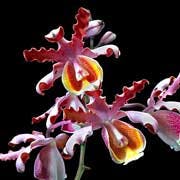
tibicinis, -e (tib-i-SIN-iss) Of a flute-player; resembling a flute or trumpet.
Ticoglossum (tee-ko-GLOSS-um) The two epiphytic species in this genus are native to Costa Rica and Panama. Halbinger described the genus in 1983, deriving the generic name from the Costa Rican word "tico," an affectionate name for Costa Ricans and the Greek word "tongue" to denote the similarity of this genus to Odontoglossum.
tigrinus, -a, -um (ti-GRYE-nus) Striped or spotted like a tiger.
tissue culture (TISH-yu KULL-chure) The culture of cells in vitro.
titanus, -a, -um (tye-TAY-nus) Very large; titanic.
Tolumnia: Tolumnia pulchella is found in Jamaica.
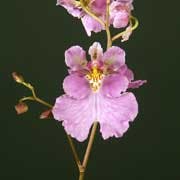
Tolumnia (toh-LUM-nee-ah) A genus of 35 species of diminutive fan-shaped epiphytes from the West Indies, formerly included in a broadly defined Oncidium and known horticulturally as equitant, or variegata oncidiums.
tomentosus, -a, -um (to-men-TOH-sus) Densely pubescent with matted hairs; woolly; tomentose.
tomentum (toh-MEN-tum) A covering of densely matted hairs.
tonsus, -a, -um (TON-sus) Sheared; smooth-shaved.
torose (TAWR-ohs) Round with swellings at the internodes.
torridus, -a, -um (TOR-rid-us) Growing in hot, dry places.
tortilis, -e (TOR-ti-liss) Twisted; coiled; tortile.
torus (TORE-uhs) The receptacle of the flower.
totipotency (toh-TIP-oh-ten-see) The principle that each cell has the genetic information needed to code for an entire individual, and hence small pieces of tissue can be used to generate adult plants through micropropagation.
toxicarius, -a, -um (tok-si-KAY-ree-us) Poisonous; toxic.
trailing (TRAY-ling) Said of plants with stems growing horizontally but not rooting along the stem.
transcription (tranz-CRIP-shun) The process of producing RNA from a DNA template.
translation (tranz-LAY-shun) The process of producing proteins from a RNA template.
translucent (tranz-LOO-sent) Partially transparent to light.
transpiration (tran-spir-AY-shun) The evaporation of water through stomata of leaves and stems.
transplanting (tranz-PLAN-ting) The transferring of seedlings from the original germinating flask to pots, or older plants from one container to another.
transversely (tranz-VERS-lee) Broader than long; at right angles to an axis.
trapeziformis, -e (trap-ee-zi-FORM-iss) An unsymmetrical four-sided figure; with four unequal sides; trapeziform.
tree fern: Tree fern is available in shaped products as well as shredded.

tree fern A large tropical or subtropical fern, generally of the family Cyatheaceae, whose fibrous trunk is used is a potting medium for orchids, either in shredded form, in the form of logs or in shaped blocks; it is commonly known by the Hawaiian term hapuu or the Brazilian xaxim .
tremulus, -a, -um (TREM-yew-lus) Quivering; trembling; tremulous.
Trevoria (treh-VORE-ee-a) The five epiphytic species in this genus are native from Nicaragua south to Bolivia. Lehmann described the genus in 1897, naming it in honor of Sir Trevor Lawrence, president of the Royal Horticultural Society and an avid orchid grower.
tri- (tri) A prefix meaning three.
triad (TRI-ad) In a group of three
triandrus, -a, -um (trye-AN-drus) With three stamens; triandrous.
Trias (TREE-ahs) There are some 10 epiphytic species in this genus ranging from India east to Thailand and Laos, with Thailand the richest in species. Lindley founded the genus in 1830, deriving the generic name from the Greek word "three" to denote the triangular flowers.
tribe (tribe) A primary taxonomic category of related genera, or the fundamental division of an order.
tricarpus, -a, -um (try-KAR-pus) Having three carpels or fruits.
Trichocentrum: Trichocentrum pulchrum is a small-growing species.
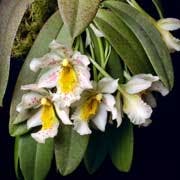
Trichocentrum (trik-oh-SEN-trum) A genus of 70 species of epiphytic orchids distributed from Mexico to Brazil and Peru. It is related to Oncidium, the name applied in 1837 by Poeppig and Endlicher, referring to the long, slender spur of the flowers of most species. The genus now includes what were formerly known as "mule ear" and "rat tail" oncidiums.
Trichoceros (trik-oh-SER-os) A genus of five epiphytic or lithophytic species of South American compact epiphytic orchids from the Andes of Colombia, Ecuador, Peru and Bolivia. Related to Telipogon, it was described in 1815 by Humboldt, Bonpland and Kunth, the name referring to the hairy antenna-like processes on each side of the column.
Trichoglottis (trik-oh-GLOT-tiss) A genus of 60 epiphytic species of vandaceous orchids from Sri Lanka to New Guinea, it was established by Blume in 1825, the name referring to the pubescence on the lip of the flowers.
trichome (TRYE-kohm) The correct botanical term for any hairlike outgrowth of the epidermis, as a hair or bristle.
Trichopilia (trik-oh-PILL-ee-ah) A genus of 33 epiphytic species of rather showy, pseudobulbous orchids distributed from Mexico to Bolivia and Brazil. It was described in 1836 by Lindley, the name derived from the fringed margin of the column.
Trichosalpinx (trik-oh-SALL-pinks) A genus of 90 epiphytic species of diminutive Neotropical epiphytes formerly included in a broadly defined Pleurothallis, characterized in part by lepanthiform leaf sheaths. The genus was established by Luer in 1983 when he removed these species from Pleurothallis.
Trichotosia (trik-oh-TOH-see-ah) A genus of 45 epiphytic species of Asian and Pacific orchids formerly included in a broadly defined Eria, usually characterized by the presence of dense, prominent trichomes. Blume founded the genus in 1825, deriving the generic name from the Greek word meaning "hairy" to denote the hair on the lip.
tricolor (TRI-kuhl-er) Three-colored.
tricostate (trye-KOSS-tayt) With three ribs.
Tridactyle (tri-DAKT-ee-lee) The 45 epiphytic species in this genus are found in tropical Africa and South Africa. Schlechter described the genus in 1914, coining the generic name from two Greek words "three or thrice" and "finger" to denote the distinct three-lobed lip.
tridentatus, -a, -um (trye-den-TAY-tus) Three-toothed; tridentate.
trifidus, -a, -um (TRYE-fid-us) Three-cleft; trifid.
trifoliatus, -a, -um (trye-foh-lee-AY-tus) Having three leaves; trifoliate.
trigeneric (trye-jen-ER-ik) Of or pertaining to three genera, usually applied in reference to hybrids derived from the combination of three parent genera.
Trigonidium: Trigonidium egertonianum is common throughout Central and South America.
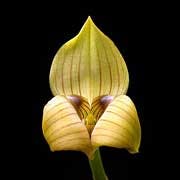
Trigonidium (trye-goh-NID-ee-um) A small genus of epiphytic orchids that range from Mexico to Brazil. Related to Maxillaria, it was described in 1837 by Lindley, who derived the name from the strongly triangular form of the sepals.
trigonous (TRI-go-nus) Three-angled.
trilinguis, -e (trye-LING-gwiss) Three-tongued.
trilobate (trye-LOH-bayt) With three lobes.
trimerous (tri-MER-us) Occurring in threes.
trimorphous (tri-MOR-fuss) Having three forms.
triploid (TRIP-loyd) Having three sets of chromosomes (3N).
tripudians (trye-PEW-dee-anz) Dancing.
tripunctatus, -a, -um (trye-punk-TAY-tus) Three-spotted.
triquetrus, -a, -um (trye-KWET-rus) Three-cornered.
trisected (tri-SEK-ted) Divided into three deeply cut parts.
Trisetella (try-se-TELL-ah) A genus of 20 Neotropical casespitose epiphytic species formerly included in a broadly defined Masdevallia. Luer founded the genus in 1989, deriving the generic name from the Latin word meaning "three hairs" to denote the tail-like projections ("tails") on the sepals.
tristis, -e (TRIS-tiss) Dull-colored; dull; sad.
triumphans (trye-UM-fanz) Conquering; excelling all others; triumphant.
Trizeuxis (trye-ZEWK-siss) A monotypic genus of tropical American dwarf epiphytes from Costa Rica to Bolivia related to Oncidium. It was founded by Lindley in 1821, the name derived from the cohesion of the three sepals.
tropicus, -a, -um (TROP-ik-us) Of or from the tropics.
Trudelia (TRUE-dell-ee-a) The five sympodial epiphytic species in this genus range from the Himalayas east to Vietnam. Garay described the genus in 1986, naming it in honor of Niklaus Trudel, a Swiss orchid grower and photographer.
trulla (TRULL-ah) Trowel-shaped.
trulliferus, -a, -um (trul-LIFF-er-us) Trowel-bearing.
trulliformis, -e (trull-i-FORM-iss) Trowel-shaped; trulliform.
truncatus, -a, -um (trun-KAY-tus) Terminating abruptly, as if shortened by removal of the apex; truncate.
tubatus, -a, -um (tew-BAY-tus) Trumpet-shaped.
tuber (TEW-ber) An underground stem or root, giving rise to new shoots and roots.
tubercle (TEW-ber-kul) A small tuber or tuberlike body, not necessarily subterranean.
tuberculatus, -a, -um (tew-ber-kew-LAY-tus) Covered with wartlike excrescences; tuberculate.
tuberiferous (TEW-ber-if-er-us Having tubers
tuberoid (TEW-ber-oyd) A thickened root resembling a tuber, as those found in many terrestrial orchids.
tuberosus, -a, -um (tew-ber-OH-sus) Having the character of a tuber; tuberlike in appearance; tuberous.
tumidus, -a, -um (TEW-mid-us) Swollen; tumid.
tunicatus, -a, -um (tew-ni-KAY-tus) Provided with concentric or enwrapping coats or layers, as the bulb of an onion; tunicate.
turbinatus, -a, -um (ter-bin-AY-tus) Inversely conical; shaped like a top; turbinate.
turface (TER-face) An extruded clay product used as an ingredient in orchid composts.
turgidus, -a, -um (TER-jid-us) Inflated, swollen to fullness; turgid.
type: Cycnoches loddigesii is the type for the genus, Cycnoches.
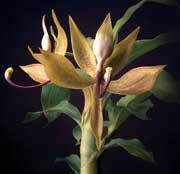
type (tipe) The original representative of a species, genus or other taxon, upon which the distinguishing characters of the taxon are based; type specimen.
type specimen (tipe SPEH-sih-men) The original material used to describe a new species, used to anchor nomenclatural usage, variously modified as: holotype, the one original element before a scientist; isotype, duplicates of the holotype; lectotype, a secondary original element selected as the nomenclatural type when the holotype has been destroyed; neotype, a specimen designated as the nomenclatural type when all original material is lacking; topotype, a specimen from the same locality as the holotype; etc.
typicus, -a, -um (TIP-ik-us) Agreeing with the type of a group; typical.








